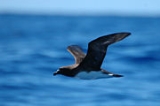
List of birds of American Samoa
Encyclopedia
This is a list of the bird species recorded in American Samoa. The avifauna of American Samoa
includes a total of 65 species, of which 5 have been introduced
by humans, 14 are rare or accidental and 1 species, the Mao
, is extirpated
. 6 species are globally threatened. American Samoa has no endemic bird species but several near-endemics occur and many of the land birds occur in good numbers. A variety of seabirds breed in the islands. Hunting and introduced predators have reduced their numbers but there are still some important breeding sites such as Lata Mountain on Ta'u Island.
This list's taxonomic
treatment (designation and sequence of orders, families, and species) and nomenclature (common and scientific names) follow the conventions of Clements
's 6th edition. The family accounts at the beginning of each heading reflects this taxonomy, as do the species counts found in each family account. Introduced and accidental species are included in the total counts for American Samoa.
The following tags have been used to highlight certain relevant categories, but not all species fall into one of these categories. Those that do not are commonly occurring, native species.
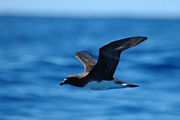 Order: Procellariiformes
Order: Procellariiformes
. Family: Procellariidae
The procellariids are the main group of medium-sized 'true petrels', characterised by united nostrils with a medium septum, and a long outer functional primary. There are about 77 species worldwide and 12 species which occur in American Samoa.
. Family: Hydrobatidae
The storm-petrel
s are relatives of the petrel
s, and are the smallest of sea-birds. They feed on plankton
ic crustaceans and small fish picked from the surface, typically while hovering. The flight is fluttering and sometimes bat
-like. There are about 20 species worldwide and 3 species which occur in American Samoa.
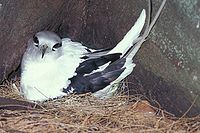 Order: Pelecaniformes
Order: Pelecaniformes
. Family: Phaethontidae
Tropicbird
s are slender white birds of tropical oceans, with exceptionally long central tail feathers. Their heads and long wings have black markings. There are 3 species worldwide and 2 species which occur in American Samoa.
 Order: Pelecaniformes
Order: Pelecaniformes
. Family: Sulidae
The sulids comprise the gannet
s and boobies
. Both groups comprise medium-to-large coastal sea-birds that plunge-dive for fish. There are about 10 species worldwide and 3 species which occur in American Samoa.
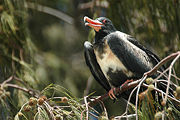 Order: Pelecaniformes
Order: Pelecaniformes
. Family: Fregatidae
Frigatebird
s are large sea-birds usually found over tropical oceans. They are large, black and white or completely black, with long wings and deeply-forked tails. The males have inflatable coloured throat pouches. They do not swim or walk, and cannot take off from a flat surface. Having the largest wingspan to body weight ratio of any bird, they are essentially aerial, able to stay aloft for more than a week. There are 5 species worldwide and 2 species which occur in American Samoa.
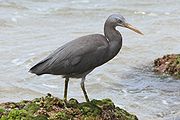 Order: Ciconiiformes
Order: Ciconiiformes
. Family: Ardeidae
The family Ardeidae contains the bittern
s, heron
s and egret
s. Herons and egrets are medium to large sized wading birds with long necks and legs. Bitterns tend to be shorter necked and more wary. Unlike other long-necked birds suck as storks, ibises and spoonbills, members of Ardeidae fly with their necks retracted. There are about 63 species worldwide and 2 species which occur in American Samoa.
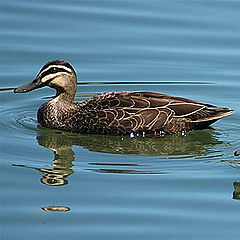 Order: Anseriformes
Order: Anseriformes
. Family: Anatidae
The family Anatidae includes the duck
s and most duck-like waterfowl, such as geese
and swan
s. These are birds that are modified for an aquatic existence with webbed feet, flattened bills and feathers that are excellent at shedding water due to an oily coating. There are about 159 species worldwide and 1 species which occurs in American Samoa.
. Family: Phasianidae
The Phasianidae are a family of terrestrial birds which consists of quail
s, partridge
s, snowcock
s, francolin
s, spurfowls, tragopan
s, monal
s, pheasant
s, peafowl
s and jungle fowls. In general, they are plump (although they may vary in size) and have broad, relatively short wings. There are about 155 species worldwide and 1 species which occurs in American Samoa.
 Order: Gruiformes
Order: Gruiformes
. Family: Rallidae
Rallidae is a large family of small to medium-sized birds which includes the rails, crakes, coot
s, and gallinule
s. Typically they inhabit dense vegetation in damp environments near lakes, swamps, or rivers. In general they are shy and secretive birds, difficult to observe. Most species have strong legs, and have long toes which are well adapted to soft, uneven surfaces. They tend to have short, rounded wings and be weak fliers. There are about 135 species worldwide and 3 species which occur in American Samoa.
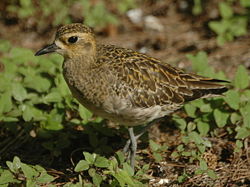 Order: Charadriiformes
Order: Charadriiformes
. Family: Charadriidae
The family Charadriidae includes the plover
s, dotterels, and lapwing
s. They are small to medium-sized birds with compact bodies, short, thick necks and long, usually pointed, wings. They are found in open country worldwide, mostly in habitats near water, although there are some exceptions. There are about 66 species worldwide and 1 species which occurs in American Samoa.
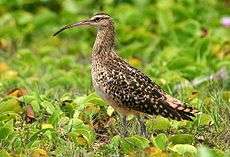 Order: Charadriiformes
Order: Charadriiformes
. Family: Scolopacidae
The Scolopacidae are a large diverse family of small to medium sized shorebirds including the sandpipers, curlew
s, godwit
s, shanks
, tattler
s, woodcock
s, snipe
s, dowitcher
s and phalarope
s. The majority of species eat small invertebrates picked out of the mud or soil. Variation in length of legs and bills enable different species to feed in the same habitat, particularly on the coast, without direct competition for food. There are about 89 species worldwide and 6 species which occur in American Samoa.
. Family: Laridae
Laridae is a family of medium to large birds seabirds and includes gull
s and kittiwake
s. They are typically grey or white, often with black markings on the head or wings. They have stout, longish bills and webbed feet. There are about 56 species worldwide and 1 species which occurs in American Samoa.
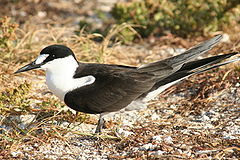 Order: Charadriiformes
Order: Charadriiformes
. Family: Sternidae
Tern
s are a group of generally general medium to large sea-birds typically with grey or white plumage, often with black markings on the head. Most terns hunt fish by diving but some pick insects off the surface of fresh water. Terns are generally long-lived birds, with several species now known to live in excess of 25 to 30 years. There are about 44 species worldwide and 9 species which occur in American Samoa.
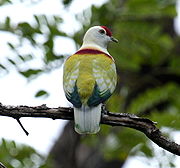 Order: Columbiformes
Order: Columbiformes
. Family: Columbidae
Pigeons and dove
s are stout-bodied birds with short necks and short slender bills with a fleshy cere
. There are about 308 species worldwide and 5 species which occur in American Samoa.
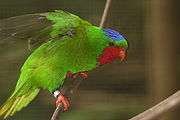 Order: Psittaciformes. Family: Psittacidae
Order: Psittaciformes. Family: Psittacidae
Parrot
s are small to large birds with a characteristic curved beak shape. Their upper mandibles have slight mobility in the joint with the skull and the have a generally erect stance. All parrots are zygodactyl, having the four toes on each foot placed two at the front and two back. There are about 347 species worldwide and 1 species which occurs in American Samoa.
. Family: Cuculidae
The family Cuculidae includes cuckoo
s, roadrunner
s and anis
. These birds are of variable size with slender bodies, long tails and strong legs. Unlike the cuckoo species of the Old World, North American cuckoos are not brood parasites. There are about 141 species worldwide and 1 species which occurs in American Samoa.
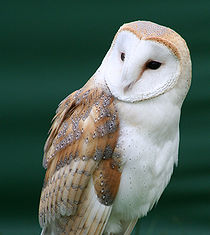 Order: Strigiformes. Family: Tytonidae
Order: Strigiformes. Family: Tytonidae
Barn owl
s are medium to large sized owls with large heads and characteristic heart-shaped faces. They have long strong legs with powerful talons. There are about 16 species worldwide and 1 species which occurs in American Samoa.
. Family: Apodidae
Swift
s are small aerial birds, spending the majority of their lives flying. These birds have very short legs and never settle voluntarily on the ground, perching instead only on vertical surfaces. Many swifts have long swept-back wings that resemble a crescent or a boomerang. There are about 100 species worldwide and 1 species which occurs in American Samoa.
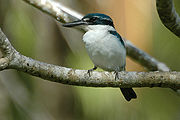 Order: Coraciiformes
Order: Coraciiformes
. Family: Alcedinidae
Kingfishers are medium-sized birds with large heads, long pointed bills, short legs, and stubby tails. There are about 93 species worldwide and 1 species which occurs in American Samoa.
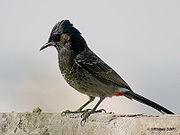 Order: Passeriformes. Family: Pycnonotidae
Order: Passeriformes. Family: Pycnonotidae
Bulbuls are medium-sized songbirds. Some are colourful with yellow, red or orange vents, cheeks, throat or supercilia, but most are drab, with uniform olive brown to black plumage. Some species have distinct crests. There are about 130 species worldwide and 1 species which occurs in American Samoa.
The monarch flycatchers are small to medium-sized insectivorous passerines, which hunt by flycatching. There are about 100 species worldwide and 1 species which occurs in American Samoa.
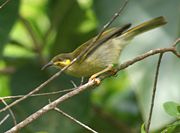 Order: Passeriformes. Family: Meliphagidae
Order: Passeriformes. Family: Meliphagidae
The honeyeaters are a large and diverse family of small to medium-sized birds most common in Australia and New Guinea. They are nectar feeders and closely resemble other nectar-feeding passerines. There are about 174 species worldwide and 3 species which occur in American Samoa.
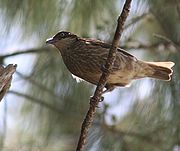 Order: Passeriformes. Family: Sturnidae
Order: Passeriformes. Family: Sturnidae
Starlings are small to medium-sized passerine birds. Their flight is strong and direct, and they are very gregarious. Their preferred habitat is fairly open country. They eat insects and fruit. Plumage is typically dark with a metallic sheen. There are about 114 species worldwide and 4 species which occur in American Samoa.
American Samoa
American Samoa is an unincorporated territory of the United States located in the South Pacific Ocean, southeast of the sovereign state of Samoa...
includes a total of 65 species, of which 5 have been introduced
Introduced species
An introduced species — or neozoon, alien, exotic, non-indigenous, or non-native species, or simply an introduction, is a species living outside its indigenous or native distributional range, and has arrived in an ecosystem or plant community by human activity, either deliberate or accidental...
by humans, 14 are rare or accidental and 1 species, the Mao
Mao (bird)
The Mao is a passerine bird belonging to the genus Gymnomyza in the honeyeater family Meliphagidae. It is an endangered species and is endemic to the Samoan Islands. Little is known about its feeding and breeding habits....
, is extirpated
Local extinction
Local extinction, also known as extirpation, is the condition of a species which ceases to exist in the chosen geographic area of study, though it still exists elsewhere...
. 6 species are globally threatened. American Samoa has no endemic bird species but several near-endemics occur and many of the land birds occur in good numbers. A variety of seabirds breed in the islands. Hunting and introduced predators have reduced their numbers but there are still some important breeding sites such as Lata Mountain on Ta'u Island.
This list's taxonomic
Taxonomy
Taxonomy is the science of identifying and naming species, and arranging them into a classification. The field of taxonomy, sometimes referred to as "biological taxonomy", revolves around the description and use of taxonomic units, known as taxa...
treatment (designation and sequence of orders, families, and species) and nomenclature (common and scientific names) follow the conventions of Clements
James Clements
Dr. James Franklin Clements was an ornithologist, author and very successful businessman. He was born in New York....
's 6th edition. The family accounts at the beginning of each heading reflects this taxonomy, as do the species counts found in each family account. Introduced and accidental species are included in the total counts for American Samoa.
The following tags have been used to highlight certain relevant categories, but not all species fall into one of these categories. Those that do not are commonly occurring, native species.
- (A) Accidental A species that rarely or accidentally occurs in American Samoa.
- (I) Introduced A species introduced to American Samoa as a consequence, direct or indirect, of human actions.
- (Ex) Extirpated A species that no longer occurs in American Samoa although populations exist elsewhere.
| Table of contents |
|---|
Non-passerines: Shearwaters and petrels . Storm-petrels . Tropicbirds . Boobies . Frigatebirds . Herons and egrets . Ducks . Pheasants and Partridges . Rails, crakes, and gallinules . Plovers . Sandpipers and allies . Gulls . Terns . Pigeons and doves . Parrots . Cuckoos . Barn owls . Swifts . Kingfishers . |
Passerines: Bulbuls . Monarch flycatchers . Honeyeaters . Starlings . |
See also References |
Shearwaters and petrels

Procellariiformes
Procellariiformes is an order of seabirds that comprises four families: the albatrosses, petrels and shearwaters, storm petrels, and diving petrels...
. Family: Procellariidae
Procellariidae
The family Procellariidae is a group of seabirds that comprises the fulmarine petrels, the gadfly petrels, the prions, and the shearwaters. This family is part of the bird order Procellariiformes , which also includes the albatrosses, the storm-petrels, and the diving petrels.The procellariids are...
The procellariids are the main group of medium-sized 'true petrels', characterised by united nostrils with a medium septum, and a long outer functional primary. There are about 77 species worldwide and 12 species which occur in American Samoa.
- Tahiti PetrelTahiti PetrelThe Tahiti Petrel, Pétrel De Tahiti, or Petrel De Tahití is a species of seabird in the Procellariidae family....
Pterodroma rostrata - Mottled PetrelMottled PetrelThe Mottled Petrel is a species of seabird and a member of the gadfly petrels. The bird is 33-35 cm in size, with a 74-82 cm wingspan....
Pterodroma inexpectata (A) - Herald PetrelHerald PetrelThe Trindade Petrel, Pterodroma arminjoniana, is a species of seabird and a member of the gadfly petrels. The bird is 35-39 cm in size, with a 88-102 cm wingspan....
Pterodroma arminjoniana - White-necked PetrelWhite-necked PetrelThe White-necked Petrel , also known as the White-naped Petrel, is a species of seabird in the Procellariidae family. During non-breeding season it occurs throughout a large part of the Pacific, but it is only known to breed on Macauley Island in New Zealand's Kermadec Islands and the Australian...
Pterodroma cervicalis - Gould's PetrelCollared PetrelThe Collared Petrel is a species of seabird in the Procellariidae family. It is sometimes regarded as a subspecies of Gould's Petrel ....
Pterodroma leucoptera - Flesh-footed ShearwaterFlesh-footed ShearwaterThe Flesh-footed Shearwater, Puffinus carneipes, is a small shearwater. Its plumage is black. It has pale pinkish feet, and a pale bill with a black tip. Together with the equally light-billed Pink-footed Shearwater, it forms the Hemipuffinus group, a superspecies which may or may not have an...
Puffinus carneipes (A) - Wedge-tailed ShearwaterWedge-tailed ShearwaterThe Wedge-tailed Shearwater, Puffinus pacificus is a medium-large shearwater in the seabird family Procellariidae. It is one of the shearwater species that is sometimes referred to as a Muttonbird, like the Sooty Shearwater of New Zealand and the Short-tailed Shearwater of Australia...
Puffinus pacificus (A) - Sooty ShearwaterSooty ShearwaterThe Sooty Shearwater is a medium-large shearwater in the seabird family Procellariidae. In New Zealand it is also known by its Māori name tītī and as "muttonbird", like its relatives the Wedge-tailed Shearwater and the Australian Short-tailed Shearwater The Sooty Shearwater (Puffinus griseus) is...
Puffinus griseus - Short-tailed ShearwaterShort-tailed ShearwaterThe Short-tailed Shearwater or Slender-billed Shearwater , also called Yolla or Moonbird, and commonly known as the muttonbird in Australia, is the most abundant seabird species in Australian waters, and is one of the few Australian native birds in which the chicks are commercially harvested...
Puffinus tenuirostris - Christmas ShearwaterChristmas ShearwaterThe Christmas Shearwater, Puffinus nativitatis, is a medium-sized shearwater of the tropical Central Pacific. It is a poorly known species due to its remote nesting habits, and it has not been extensively studied at sea either....
Puffinus nativitatis - Townsend's ShearwaterNewell's ShearwaterNewell's Shearwater or Hawaiian Shearwater is a seabird belonging to the genus Puffinus in the family Procellariidae. It belongs to a confusing group of shearwaters which are difficult to identify and whose classification is controversial...
Puffinus auricularis (A) - Audubon's ShearwaterAudubon's ShearwaterAudubon's Shearwater, Puffinus lherminieri, is a common tropical seabird from the family Procellariidae. Sometimes called Dusky-backed Shearwater, the scientific name of this species commemorates the French naturalist Félix Louis L'Herminier....
Puffinus lherminieri
Storm-petrels
Order: ProcellariiformesProcellariiformes
Procellariiformes is an order of seabirds that comprises four families: the albatrosses, petrels and shearwaters, storm petrels, and diving petrels...
. Family: Hydrobatidae
The storm-petrel
Storm-petrel
Storm petrels are seabirds in the family Hydrobatidae, part of the order Procellariiformes. These smallest of seabirds feed on planktonic crustaceans and small fish picked from the surface, typically while hovering. The flight is fluttering and sometimes bat-like.Storm petrels have a cosmopolitan...
s are relatives of the petrel
Petrel
Petrels are tube-nosed seabirds in the bird order Procellariiformes. The common name does not indicate relationship beyond that point, as "petrels" occur in three of the four families within that group...
s, and are the smallest of sea-birds. They feed on plankton
Plankton
Plankton are any drifting organisms that inhabit the pelagic zone of oceans, seas, or bodies of fresh water. That is, plankton are defined by their ecological niche rather than phylogenetic or taxonomic classification...
ic crustaceans and small fish picked from the surface, typically while hovering. The flight is fluttering and sometimes bat
Bat
Bats are mammals of the order Chiroptera "hand" and pteron "wing") whose forelimbs form webbed wings, making them the only mammals naturally capable of true and sustained flight. By contrast, other mammals said to fly, such as flying squirrels, gliding possums, and colugos, glide rather than fly,...
-like. There are about 20 species worldwide and 3 species which occur in American Samoa.
- White-faced Storm-PetrelWhite-faced Storm-petrelThe White-faced Storm Petrel , also known as White-faced Petrel is a small seabird of the storm-petrel family. It is the only member of the monotypic genus Pelagodroma....
Pelagodroma marina (A) - Black-bellied Storm-PetrelBlack-bellied Storm-petrelThe Black-bellied Storm Petrel is a species of seabird in the Hydrobatidae family.It is found in Antarctica, Argentina, Australia, Bouvet Island, Brazil, Chile, Falkland Islands, French Polynesia, French Southern Territories, Madagascar, Mozambique, New Zealand, Oman, Peru, Saint Helena, São Tomé...
Fregetta tropica (A) - Polynesian Storm-PetrelPolynesian Storm-petrelThe Polynesian Storm Petrel is a species of seabird in the Hydrobatidae family. It is placed in the monotypic genus Nesofregetta....
Nesofregetta fuliginosa
Tropicbirds

Pelecaniformes
The Pelecaniformes is a order of medium-sized and large waterbirds found worldwide. As traditionally—but erroneously—defined, they encompass all birds that have feet with all four toes webbed. Hence, they were formerly also known by such names as totipalmates or steganopodes...
. Family: Phaethontidae
Tropicbird
Tropicbird
Tropicbirds are a family, Phaethontidae, of tropical pelagic seabirds now classified in their own order Phaethontiformes. Their relationship to other living birds is unclear, and they appear to have no close relatives. There are three species in one genus, Phaethon...
s are slender white birds of tropical oceans, with exceptionally long central tail feathers. Their heads and long wings have black markings. There are 3 species worldwide and 2 species which occur in American Samoa.
- Red-tailed TropicbirdRed-tailed TropicbirdThe Red-tailed Tropicbird, Phaethon rubricauda, is a seabird that nests across the Indian and Pacific Oceans. It is the rarest of the tropicbirds, yet is still a widespread bird that is not considered threatened. It nests in colonies on oceanic islands....
Phaethon rubricauda - White-tailed TropicbirdWhite-tailed TropicbirdThe White-tailed Tropicbird Phaethon lepturus, is a tropicbird, smallest of three closely related seabirds of the tropical oceans and smallest member of the order Phaethontiformes. It occurs in the tropical Atlantic, western Pacific and Indian Oceans...
Phaethon lepturus
Boobies

Pelecaniformes
The Pelecaniformes is a order of medium-sized and large waterbirds found worldwide. As traditionally—but erroneously—defined, they encompass all birds that have feet with all four toes webbed. Hence, they were formerly also known by such names as totipalmates or steganopodes...
. Family: Sulidae
Sulidae
The bird family Sulidae comprises the gannets and boobies. Collectively called sulidas, they are medium-large coastal seabirds that plunge-dive for fish and similar prey. The ten species in this family are often considered congeneric in older sources, placing all in the genus Sula...
The sulids comprise the gannet
Gannet
Gannets are seabirds comprising the genus Morus, in the family Sulidae, closely related to the boobies.The gannets are large black and white birds with yellow heads. They have long pointed wings and long bills. Northern gannets are the largest seabirds in the North Atlantic, with a wingspan of up...
s and boobies
Booby
A booby is a seabird in the genus Sula, part of the Sulidae family. Boobies are closely related to the gannets , which were formerly included in Sula.-Description:...
. Both groups comprise medium-to-large coastal sea-birds that plunge-dive for fish. There are about 10 species worldwide and 3 species which occur in American Samoa.
- Masked BoobyMasked BoobyThe Masked Booby, Sula dactylatra, is a large seabird of the booby family, Sulidae. This species breeds on islands in tropical oceans, except in the eastern Atlantic; in the eastern Pacific it is replaced by the Nazca Booby, Sula granti, which was formerly regarded as a subspecies of Masked Booby...
Sula dactylatra - Red-footed BoobyRed-footed BoobyThe Red-footed Booby, Sula sula, is a large seabird of the booby family, Sulidae. As suggested by the name, adults always have red feet, but the colour of the plumage varies. They are powerful and agile fliers, but they are clumsy in takeoffs and landings...
Sula sula - Brown BoobyBrown BoobyThe Brown Booby is a large seabird of the booby family, Sulidae. The adult brown booby reaches about in length. Its head and upper body are covered in dark brown, with the remainder being a contrasting white. The juvenile form is gray-brown with darkening on the head, wings and tail...
Sula leucogaster
Frigatebirds

Pelecaniformes
The Pelecaniformes is a order of medium-sized and large waterbirds found worldwide. As traditionally—but erroneously—defined, they encompass all birds that have feet with all four toes webbed. Hence, they were formerly also known by such names as totipalmates or steganopodes...
. Family: Fregatidae
Frigatebird
Frigatebird
The frigatebirds are a family, Fregatidae, of seabirds. There are five species in the single genus Fregata. They are also sometimes called Man of War birds or Pirate birds. Since they are related to the pelicans, the term "frigate pelican" is also a name applied to them...
s are large sea-birds usually found over tropical oceans. They are large, black and white or completely black, with long wings and deeply-forked tails. The males have inflatable coloured throat pouches. They do not swim or walk, and cannot take off from a flat surface. Having the largest wingspan to body weight ratio of any bird, they are essentially aerial, able to stay aloft for more than a week. There are 5 species worldwide and 2 species which occur in American Samoa.
- Great FrigatebirdGreat FrigatebirdThe Great Frigatebird is a large dispersive seabird in the frigatebird family. Major nesting populations are found in the Pacific and Indian Oceans, as well as a population in the South Atlantic....
Fregata minor - Lesser FrigatebirdLesser FrigatebirdThe Lesser Frigatebird, Fregata ariel, is a species of frigatebird.It nests in Australia, among other locations.There is a single record from the Western Palearctic, from Eilat in the Gulf of Aqaba....
Fregata ariel
Herons and egrets

Ciconiiformes
Traditionally, the order Ciconiiformes has included a variety of large, long-legged wading birds with large bills: storks, herons, egrets, ibises, spoonbills, and several others. Ciconiiformes are known from the Late Eocene...
. Family: Ardeidae
The family Ardeidae contains the bittern
Bittern
Bitterns are a classification of birds in the heron family, Ardeidae, a family of wading birds. Species named bitterns tend to be the shorter-necked, often more secretive members of this family...
s, heron
Heron
The herons are long-legged freshwater and coastal birds in the family Ardeidae. There are 64 recognised species in this family. Some are called "egrets" or "bitterns" instead of "heron"....
s and egret
Egret
An egret is any of several herons, most of which are white or buff, and several of which develop fine plumes during the breeding season. Many egrets are members of the genera Egretta or Ardea which contain other species named as herons rather than egrets...
s. Herons and egrets are medium to large sized wading birds with long necks and legs. Bitterns tend to be shorter necked and more wary. Unlike other long-necked birds suck as storks, ibises and spoonbills, members of Ardeidae fly with their necks retracted. There are about 63 species worldwide and 2 species which occur in American Samoa.
- White-faced HeronWhite-faced HeronThe White-faced Heron, Egretta novaehollandiae, also known as the White-fronted Heron, and incorrectly as the Grey Heron, or Blue Crane, is a common bird throughout most of Australasia, including New Guinea, the islands of Torres Strait, Indonesia, New Zealand, the islands of the Subantarctic, and...
Egretta novaehollandiae (A) - Pacific Reef-Heron Egretta sacra
Ducks

Anseriformes
The order Anseriformes contains about 150 living species of birds in three extant families: the Anhimidae , Anseranatidae , and the Anatidae, which includes over 140 species of waterfowl, among them the ducks, geese, and swans.All species in the order are highly adapted for an aquatic existence at...
. Family: Anatidae
Anatidae
Anatidae is the biological family of birds that includes ducks, geese and swans. The family has a cosmopolitan distribution, occurring on all the world's continents except Antarctica and on most of the world's islands and island groups...
The family Anatidae includes the duck
Duck
Duck is the common name for a large number of species in the Anatidae family of birds, which also includes swans and geese. The ducks are divided among several subfamilies in the Anatidae family; they do not represent a monophyletic group but a form taxon, since swans and geese are not considered...
s and most duck-like waterfowl, such as geese
Goose
The word goose is the English name for a group of waterfowl, belonging to the family Anatidae. This family also includes swans, most of which are larger than true geese, and ducks, which are smaller....
and swan
Swan
Swans, genus Cygnus, are birds of the family Anatidae, which also includes geese and ducks. Swans are grouped with the closely related geese in the subfamily Anserinae where they form the tribe Cygnini. Sometimes, they are considered a distinct subfamily, Cygninae...
s. These are birds that are modified for an aquatic existence with webbed feet, flattened bills and feathers that are excellent at shedding water due to an oily coating. There are about 159 species worldwide and 1 species which occurs in American Samoa.
- Pacific Black DuckPacific Black DuckThe Pacific Black Duck is a dabbling duck found in much of Indonesia, New Guinea, Australia, New Zealand, and many islands in the southwestern Pacific, reaching to the Caroline Islands in the north and French Polynesia in the east. It is usually called the Grey Duck in New Zealand...
Anas superciliosa
Pheasants and partridges
Order: GalliformesGalliformes
Galliformes are an order of heavy-bodied ground-feeding domestic or game bird, containing turkey, grouse, chicken, New and Old World Quail, ptarmigan, partridge, pheasant, and the Cracidae. Common names are gamefowl or gamebirds, landfowl, gallinaceous birds or galliforms...
. Family: Phasianidae
Phasianidae
The Phasianidae is a family of birds which consists of the pheasants and partridges, including the junglefowl , Old World Quail, francolins, monals and peafowl. The family is a large one, and is occasionally broken up into two subfamilies, the Phasianinae, and the Perdicinae...
The Phasianidae are a family of terrestrial birds which consists of quail
Quail
Quail is a collective name for several genera of mid-sized birds generally considered in the order Galliformes. Old World quail are found in the family Phasianidae, while New World quail are found in the family Odontophoridae...
s, partridge
Partridge
Partridges are birds in the pheasant family, Phasianidae. They are a non-migratory Old World group.These are medium-sized birds, intermediate between the larger pheasants and the smaller quails. Partridges are native to Europe, Asia, Africa, and the Middle East...
s, snowcock
Snowcock
The snowcocks are a group of bird species in the genus Tetraogallus of the pheasant family, Phasianidae. They are ground-nesting birds which breed in the mountain ranges of southern Eurasia from the Caucasus to the Himalayas and western China. The Himalayan Snowcock has been introduced...
s, francolin
Francolin
Francolins are birds that traditionally have been placed in the genus Francolinus, but now commonly are divided into multiple genera , although some of the major taxonomic listing sources have yet to divide them. They are members of the pheasant family, Phasianidae...
s, spurfowls, tragopan
Tragopan
Tragopan is a genus of bird in the family Phasianidae. These birds are commonly called "horny pheasants" because of two brightly-colored, fleshy horns on their heads that they can erect during courtship displays...
s, monal
Monal
A Monal is a bird of genus Lophophorus of the Pheasant family, Phasianidae. There are three species and several sub-species within the genus Lophophorus:* Himalayan Monal Lophophorus impejanus* Sclater's Monal Lophophorus sclateri...
s, pheasant
Pheasant
Pheasants refer to some members of the Phasianinae subfamily of Phasianidae in the order Galliformes.Pheasants are characterised by strong sexual dimorphism, males being highly ornate with bright colours and adornments such as wattles and long tails. Males are usually larger than females and have...
s, peafowl
Peafowl
Peafowl are two Asiatic species of flying birds in the genus Pavo of the pheasant family, Phasianidae, best known for the male's extravagant eye-spotted tail, which it displays as part of courtship. The male is called a peacock, the female a peahen, and the offspring peachicks. The adult female...
s and jungle fowls. In general, they are plump (although they may vary in size) and have broad, relatively short wings. There are about 155 species worldwide and 1 species which occurs in American Samoa.
- Red JunglefowlRed JunglefowlThe Red Junglefowl is a tropical member of the Pheasant family. They are thought to be ancestors of the domestic chicken with some hybridisation with the Grey Junglefowl...
Gallus gallus (I)
Rails, crakes, and gallinules

Gruiformes
The Gruiformes are an order containing a considerable number of living and extinct bird families, with a widespread geographical diversity. Gruiform means "crane-like"....
. Family: Rallidae
Rallidae
The rails, or Rallidae, are a large cosmopolitan family of small to medium-sized birds. The family exhibits considerable diversity and the family also includes the crakes, coots, and gallinules...
Rallidae is a large family of small to medium-sized birds which includes the rails, crakes, coot
Coot
Coots are medium-sized water birds that are members of the rail family Rallidae. They constitute the genus Fulica. Coots have predominantly black plumage, and, unlike many of the rails, they are usually easy to see, often swimming in open water...
s, and gallinule
Rallidae
The rails, or Rallidae, are a large cosmopolitan family of small to medium-sized birds. The family exhibits considerable diversity and the family also includes the crakes, coots, and gallinules...
s. Typically they inhabit dense vegetation in damp environments near lakes, swamps, or rivers. In general they are shy and secretive birds, difficult to observe. Most species have strong legs, and have long toes which are well adapted to soft, uneven surfaces. They tend to have short, rounded wings and be weak fliers. There are about 135 species worldwide and 3 species which occur in American Samoa.
- Buff-banded RailBuff-banded RailThe Buff-banded Rail, Gallirallus philippensis is a distinctively coloured, highly dispersive, medium-sized rail of the family Rallidae....
Gallirallus philippensis - Spotless CrakeSpotless CrakeThe Spotless Crake is a species of bird in the rail family, Rallidae.It is found in American Samoa, Australia, the Cook Islands, Fiji, French Polynesia, Indonesia, Micronesia, New Zealand, Niue, Papua New Guinea, the Philippines, Pitcairn, Samoa, Solomon Islands, and Tonga.-References:* BirdLife...
Porzana tabuensis - Purple SwamphenPurple SwamphenThe Purple Swamphen , also known as the African Purple Swamphen, Purple Moorhen, Purple Gallinule, Pūkeko or Purple Coot, is a large bird in the family Rallidae . From its name in French, talève sultane, it is also known as the Sultana Bird...
Porphyrio porphyrio
Plovers

Charadriiformes
Charadriiformes is a diverse order of small to medium-large birds. It includes about 350 species and has members in all parts of the world. Most Charadriiformes live near water and eat invertebrates or other small animals; however, some are pelagic , some occupy deserts and a few are found in thick...
. Family: Charadriidae
Charadriidae
The bird family Charadriidae includes the plovers, dotterels, and lapwings, about 64 to 66 species in all.- Morphology :They are small to medium-sized birds with compact bodies, short, thick necks and long, usually pointed, wings, but most species of lapwing may have more rounded wings...
The family Charadriidae includes the plover
Plover
Plovers are a widely distributed group of wading birds belonging to the subfamily Charadriinae. There are about 40 species in the subfamily, most of them called "plover" or "dotterel". The closely related lapwing subfamily, Vanellinae, comprises another 20-odd species.Plovers are found throughout...
s, dotterels, and lapwing
Lapwing
Vanellinae are any of various crested plovers, family Charadriidae, noted for its slow, irregular wingbeat in flight and a shrill, wailing cry. Its length is 10-16 inches. They are a subfamily of medium-sized wading birds which also includes the plovers and dotterels. The Vanellinae are...
s. They are small to medium-sized birds with compact bodies, short, thick necks and long, usually pointed, wings. They are found in open country worldwide, mostly in habitats near water, although there are some exceptions. There are about 66 species worldwide and 1 species which occurs in American Samoa.
- Pacific Golden-Plover Pluvialis fulva
Sandpipers and allies

Charadriiformes
Charadriiformes is a diverse order of small to medium-large birds. It includes about 350 species and has members in all parts of the world. Most Charadriiformes live near water and eat invertebrates or other small animals; however, some are pelagic , some occupy deserts and a few are found in thick...
. Family: Scolopacidae
Scolopacidae
The sandpipers are a large family, Scolopacidae, of waders or shorebirds. They include many species called sandpipers, as well as those called by names such as curlew and snipe. The majority of these species eat small invertebrates picked out of the mud or soil...
The Scolopacidae are a large diverse family of small to medium sized shorebirds including the sandpipers, curlew
Curlew
The curlews , genus Numenius, are a group of eight species of birds, characterised by long, slender, downcurved bills and mottled brown plumage. They are one of the most ancient lineages of scolopacid waders, together with the godwits which look similar but have straight bills...
s, godwit
Godwit
The godwits are a group of large, long-billed, long-legged and strongly migratory wading birds of the genus Limosa. They form large flocks on coasts and estuaries in winter....
s, shanks
Tringa
Tringa is a genus of waders, containing the shanks and tattlers. They are mainly freshwater birds, often with brightly coloured legs as reflected in the English names of six species, as well as the specific names of two of these and the Green Sandpiper. They are typically associated with northern...
, tattler
Tattler (bird)
The tattlers are the two very similar bird species in the shorebird genus Tringa. They formerly had their own genus, Heteroscelus. The old genus name means "different leg" in Greek, referring to the leg scales that differentiate the tattlers from their close relatives, the shanks.The species are:*...
s, woodcock
Woodcock
The woodcocks are a group of seven or eight very similar living species of wading birds in the genus Scolopax. Only two woodcocks are widespread, the others being localized island endemics. Most are found in the Northern Hemisphere but a few range into Wallacea...
s, snipe
Snipe
A snipe is any of about 25 wading bird species in three genera in the family Scolopacidae. They are characterized by a very long, slender bill and crypsis plumage. The Gallinago snipes have a nearly worldwide distribution, the Lymnocryptes Jack Snipe is restricted to Asia and Europe and the...
s, dowitcher
Dowitcher
The three dowitchers are medium-sized long-billed wading birds. They resemble godwits in body and bill shape, and the reddish underparts in summer, but are much shorter legged, more like snipe to which they are also somewhat closer related...
s and phalarope
Phalarope
A phalarope or wadepiper is any of three living species of slender-necked shorebirds in the genus Phalaropus of the bird family Scolopacidae. They are close relatives of the shanks and tattlers, the Actitis and Terek Sandpipers, and also of the turnstones and calidrids...
s. The majority of species eat small invertebrates picked out of the mud or soil. Variation in length of legs and bills enable different species to feed in the same habitat, particularly on the coast, without direct competition for food. There are about 89 species worldwide and 6 species which occur in American Samoa.
- Bar-tailed GodwitBar-tailed GodwitThe Bar-tailed Godwit is a large wader in the family Scolopacidae, which breeds on Arctic coasts and tundra mainly in the Old World, and winters on coasts in temperate and tropical regions of the Old World...
Limosa lapponica (A) - WhimbrelWhimbrelThe Whimbrel Numenius phaeopus, is a wader in the large family Scolopacidae. It is one of the mostwidespread of the curlews, breeding across much of subarctic North America, Europe and Asia as far south as Scotland....
Numenius phaeopus (A) - Bristle-thighed CurlewBristle-thighed CurlewThe Bristle-thighed Curlew, Numenius tahitiensis, is a large shorebird that breeds in Alaska and winters on tropical Pacific islands. It has a long, decurved bill and bristled feathers at the base of the legs. Its length is about 43 cm and wingspan about 84 cm...
Numenius tahitiensis - Wandering TattlerWandering TattlerThe Wandering Tattler, Tringa incana , is a medium-sized wading bird. It is similar in appearance to the closely related Gray-tailed Tattler, T. brevipes...
Heterosceles incanus - Ruddy TurnstoneRuddy TurnstoneThe Ruddy Turnstone is a small wading bird, one of two species of turnstone in the genus Arenaria. It is now classified in the sandpiper family Scolopacidae but was formerly sometimes placed in the plover family Charadriidae...
Arenaria interpres - SanderlingSanderlingThe Sanderling is a small wader. It is a circumpolar Arctic breeder, and is a long-distance migrant, wintering south to South America, South Europe, Africa, and Australia...
Calidris alba (A)
Gulls
Order: CharadriiformesCharadriiformes
Charadriiformes is a diverse order of small to medium-large birds. It includes about 350 species and has members in all parts of the world. Most Charadriiformes live near water and eat invertebrates or other small animals; however, some are pelagic , some occupy deserts and a few are found in thick...
. Family: Laridae
Laridae is a family of medium to large birds seabirds and includes gull
Gull
Gulls are birds in the family Laridae. They are most closely related to the terns and only distantly related to auks, skimmers, and more distantly to the waders...
s and kittiwake
Kittiwake
The kittiwakes are two closely related seabird species in the gull family Laridae, the Black-legged Kittiwake and the Red-legged Kittiwake . The epithets "Black-legged" and "Red-legged" are used to distinguish the two species in North America, but in Europe, where R...
s. They are typically grey or white, often with black markings on the head or wings. They have stout, longish bills and webbed feet. There are about 56 species worldwide and 1 species which occurs in American Samoa.
- Laughing GullLaughing GullThe Laughing Gull, Leucophaeus atricilla, is a medium-sized gull of North and South America. It breeds on the Atlantic coast of North America, the Caribbean, and northern South America. Northernmost populations migrate further south in winter, and this species occurs as a rare vagrant to western...
Larus atricilla (A)
Terns

Charadriiformes
Charadriiformes is a diverse order of small to medium-large birds. It includes about 350 species and has members in all parts of the world. Most Charadriiformes live near water and eat invertebrates or other small animals; however, some are pelagic , some occupy deserts and a few are found in thick...
. Family: Sternidae
Tern
Tern
Terns are seabirds in the family Sternidae, previously considered a subfamily of the gull family Laridae . They form a lineage with the gulls and skimmers which in turn is related to skuas and auks...
s are a group of generally general medium to large sea-birds typically with grey or white plumage, often with black markings on the head. Most terns hunt fish by diving but some pick insects off the surface of fresh water. Terns are generally long-lived birds, with several species now known to live in excess of 25 to 30 years. There are about 44 species worldwide and 9 species which occur in American Samoa.
- Great Crested Tern Sterna bergii (A)
- Black-naped TernBlack-naped TernThe Black-naped Tern is an oceanic tern mostly found in tropical and subtropical areas of the Pacific and Indian Oceans. It is rarely found inland....
Sterna sumatrana (A) - Gray-backed Tern Sterna lunata
- Bridled TernBridled TernThe Bridled Tern is a seabird of the tern family Sternidae. It is a bird of the tropical oceans.-Description:...
Sterna anaethetus (A) - Sooty TernSooty TernThe Sooty Tern, Onychoprion fuscatus , is a seabird of the tern family . It is a bird of the tropical oceans, breeding on islands throughout the equatorial zone. Colloquially, it is known as the Wideawake Tern or just wideawake...
Sterna fuscata - Black NoddyBlack NoddyThe Black Noddy or White-capped Noddy is a seabird from the tern family. It resembles the closely related Brown or Common Noddy , but is smaller with darker plumage, a whiter cap, a longer, straighter beak and shorter tail...
Anous minutus - Brown NoddyBrown NoddyThe Brown Noddy or Common Noddy is a seabird from the tern family. The largest of the noddies, it can be told from the closely related Black Noddy by its larger size and plumage, which is dark brown rather than black...
Anous stolidus - Blue NoddyBlue NoddyThe Blue Noddy is a species of tern in the Sternidae family. It is also known as the Blue-grey Noddy.It is found in American Samoa, the Cook Islands, Fiji, French Polynesia, Kiribati, Marshall Islands, New Caledonia, Samoa, Tonga , Tuvalu and Hawaii. It has occurred as a vagrant in Australia and...
Procelsterna cerulea - White TernWhite TernThe White Tern is a small seabird found across the tropical oceans of the world. It is sometimes known as the Fairy Tern although this name is potentially confusing as it is the common name of the Fairy Tern Sternula nereis...
Gygis alba
Pigeons and doves

Columbiformes
Columbiformes are an avian order that includes the very widespread and successful doves and pigeons, classified in the family Columbidae, and the extinct Dodo and the Rodrigues Solitaire, long classified as a second family Raphidae. 313 species, found worldwide, comprise the Columbiformes order....
. Family: Columbidae
Pigeons and dove
Dove
Pigeons and doves constitute the bird family Columbidae within the order Columbiformes, which include some 300 species of near passerines. In general terms "dove" and "pigeon" are used somewhat interchangeably...
s are stout-bodied birds with short necks and short slender bills with a fleshy cere
Cère
The Cère is a long river in south-western France, left tributary of the Dordogne River. Its source is in the south-western Massif Central, near the mountain Plomb du Cantal...
. There are about 308 species worldwide and 5 species which occur in American Samoa.
- Rock PigeonRock PigeonThe Rock Dove or Rock Pigeon, is a member of the bird family Columbidae . In common usage, this bird is often simply referred to as the "pigeon"....
Columba livia (I) - Friendly Ground-dove Gallicolumba stairi
- Many-coloured Fruit-doveMany-coloured Fruit-doveThe Many-coloured Fruit Dove is a species of bird in the Columbidae family. It occurs on islands in the south-west Pacific Ocean where it is found in Fiji, the Samoan Islands, and Tonga. Its natural habitat is subtropical or tropical moist lowland forests. It usually feeds high in the canopy on...
Ptilinopus perousii - Purple-capped Fruit-dovePurple-capped Fruit-doveThe Crimson-crowned Fruit Dove , also known as the Purple-capped Fruit Dove , is a species of bird in the Columbidae family.It is found in American Samoa, Fiji, Marshall Islands, Micronesia, Niue, Samoa, Tonga, and Wallis and Futuna...
Ptilinopus porphyraceus - Pacific Imperial-pigeonPacific Imperial-pigeonThe Pacific Imperial Pigeon is a widespread species of pigeon in the family Columbidae.It is found in American Samoa, the Cook Islands, the smaller islands of eastern Fiji, Kiribati, Niue, the smaller satellite islands of Papua New Guinea, Samoa, Solomon Islands, Tokelau, Tonga, Tuvalu, Vanuatu,...
Ducula pacifica
Parrots

Parrot
Parrot
Parrots, also known as psittacines , are birds of the roughly 372 species in 86 genera that make up the order Psittaciformes, found in most tropical and subtropical regions. The order is subdivided into three families: the Psittacidae , the Cacatuidae and the Strigopidae...
s are small to large birds with a characteristic curved beak shape. Their upper mandibles have slight mobility in the joint with the skull and the have a generally erect stance. All parrots are zygodactyl, having the four toes on each foot placed two at the front and two back. There are about 347 species worldwide and 1 species which occurs in American Samoa.
- Blue-crowned LorikeetBlue-crowned LorikeetThe Blue-crowned Lorikeet is a parrot found throughout the Samoa and Tonga islands and Lau archipelago, including: ʻAlofi, Fotuhaʻa, Fulago, Futuna, Haʻafeva, Niuafoʻou, Moce, Niuē, Ofu, Olosega, Sāmoa, Savaiʻi, Tafahi, Taʻu, Tofua, Tonga, Tungua, ʻUiha, ʻUpolu, Varoa, Vavaʻu, and Voleva...
Vini australis
Cuckoos
Order: CuculiformesCuculiformes
The near passerine bird order Cuculiformes traditionally included three families as below:* Musophagidae - turacos and allies* Cuculidae - cuckoos, coucals, roadrunners and anis* Opisthocomidae - Hoatzin...
. Family: Cuculidae
The family Cuculidae includes cuckoo
Cuckoo
The cuckoos are a family, Cuculidae, of near passerine birds. The order Cuculiformes, in addition to the cuckoos, also includes the turacos . Some zoologists and taxonomists have also included the unique Hoatzin in the Cuculiformes, but its taxonomy remains in dispute...
s, roadrunner
Geococcyx
The roadrunners are two species of bird in the genus Geococcyx of the cuckoo family, Cuculidae, native to North and Central America...
s and anis
Ani (bird)
The anis are the three species of near-passerine birds in the genus Crotophaga of the cuckoo family. They are essentially tropical New world birds, although the range of two species just reaches the United States...
. These birds are of variable size with slender bodies, long tails and strong legs. Unlike the cuckoo species of the Old World, North American cuckoos are not brood parasites. There are about 141 species worldwide and 1 species which occurs in American Samoa.
- Long-tailed Koel Eudynamys taitensis
Barn owls

Tytonidae
Barn-owls are one of the two families of owls, the other being the true owls, Strigidae. They are medium to large sized owls with large heads and characteristic heart-shaped faces. They have long, strong legs with powerful talons...
Barn owl
Barn Owl
The Barn Owl is the most widely distributed species of owl, and one of the most widespread of all birds. It is also referred to as Common Barn Owl, to distinguish it from other species in the barn-owl family Tytonidae. These form one of two main lineages of living owls, the other being the typical...
s are medium to large sized owls with large heads and characteristic heart-shaped faces. They have long strong legs with powerful talons. There are about 16 species worldwide and 1 species which occurs in American Samoa.
- Barn OwlBarn OwlThe Barn Owl is the most widely distributed species of owl, and one of the most widespread of all birds. It is also referred to as Common Barn Owl, to distinguish it from other species in the barn-owl family Tytonidae. These form one of two main lineages of living owls, the other being the typical...
Tyto alba
Swifts
Order: ApodiformesApodiformes
Traditionally, the bird order Apodiformes contained three living families: the swifts , the tree swifts , and the hummingbirds . In the Sibley-Ahlquist taxonomy, this order is raised to a superorder Apodimorphae in which hummingbirds are separated as a new order, Trochiliformes...
. Family: Apodidae
Swift
Swift
The swifts are a family, Apodidae, of highly aerial birds. They are superficially similar to swallows, but are actually not closely related to passerine species at all; swifts are in the separate order Apodiformes, which they share with hummingbirds...
s are small aerial birds, spending the majority of their lives flying. These birds have very short legs and never settle voluntarily on the ground, perching instead only on vertical surfaces. Many swifts have long swept-back wings that resemble a crescent or a boomerang. There are about 100 species worldwide and 1 species which occurs in American Samoa.
- White-rumped SwiftletWhite-rumped SwiftletThe White-rumped Swiftlet is a species of swift in the Apodidae family.It is found in American Samoa, Fiji, New Caledonia, Papua New Guinea, Samoa, Solomon Islands, Tonga, and Vanuatu...
Aerodramus spodiopygius
Kingfishers

Coraciiformes
The Coraciiformes are a group of usually colorful near passerine birds including the kingfishers, the Hoopoe, the bee-eaters, the rollers, and the hornbills...
. Family: Alcedinidae
Kingfishers are medium-sized birds with large heads, long pointed bills, short legs, and stubby tails. There are about 93 species worldwide and 1 species which occurs in American Samoa.
- Collared KingfisherCollared KingfisherThe Collared Kingfisher is a medium-sized kingfisher belonging to the family Halcyonidae, the tree kingfishers. It is also known as the White-collared Kingfisher or Mangrove Kingfisher. It has a wide range extending from the Red Sea across southern Asia and Australasia to Polynesia...
Todirhamphus chloris
Bulbuls

Bulbuls are medium-sized songbirds. Some are colourful with yellow, red or orange vents, cheeks, throat or supercilia, but most are drab, with uniform olive brown to black plumage. Some species have distinct crests. There are about 130 species worldwide and 1 species which occurs in American Samoa.
- Red-vented BulbulRed-vented BulbulThe Red-vented Bulbul is a member of the bulbul family of passerine birds. It is resident breeder in tropical southern Asia from India and Sri Lanka east to Burma and southwestern China. It has been introduced and has established itself in the wild in many Pacific islands including Fiji, Samoa,...
Pycnonotus cafer (I)
Monarch flycatchers
Order: Passeriformes. Family: MonarchidaeThe monarch flycatchers are small to medium-sized insectivorous passerines, which hunt by flycatching. There are about 100 species worldwide and 1 species which occurs in American Samoa.
- Fiji ShrikebillFiji ShrikebillThe Fiji Shrikebill is a songbird species in the family Monarchidae. The Manu'a Shrikebill, subspecies powelli may have gone extinct in the 1990 due to habitat destruction....
Clytorhynchus vitiensis
Honeyeaters

The honeyeaters are a large and diverse family of small to medium-sized birds most common in Australia and New Guinea. They are nectar feeders and closely resemble other nectar-feeding passerines. There are about 174 species worldwide and 3 species which occur in American Samoa.
- Cardinal MyzomelaCardinal MyzomelaThe Cardinal Myzomela is a species of bird in the Honeyeater family. It is named for the scarlet color of the male. It is found in American Samoa, Samoa, Solomon Islands, and Vanuatu. Its natural habitats are subtropical or tropical moist lowland forests and subtropical or tropical mangrove...
Myzomela cardinalis - Wattled HoneyeaterWattled HoneyeaterThe Wattled Honeyeater is a species of bird in the honeyeater family Meliphagidae. It is the only species in the genus Foulehaio....
Foulehaio carunculata - MaoMao (bird)The Mao is a passerine bird belonging to the genus Gymnomyza in the honeyeater family Meliphagidae. It is an endangered species and is endemic to the Samoan Islands. Little is known about its feeding and breeding habits....
Gymnomyza samoensis (Ex)
Starlings

Starlings are small to medium-sized passerine birds. Their flight is strong and direct, and they are very gregarious. Their preferred habitat is fairly open country. They eat insects and fruit. Plumage is typically dark with a metallic sheen. There are about 114 species worldwide and 4 species which occur in American Samoa.
- Polynesian StarlingPolynesian StarlingThe Polynesian Starling is a species of starling of the family Sturnidae. It is found in American Samoa, Samoa, Fiji, Niue, Tonga, the Santa Cruz Islands, and Wallis and Futuna Islands. Its natural habitats are subtropical or tropical dry forests and tropical moist forests...
Aplonis tabuensis - Samoan StarlingSamoan StarlingThe Samoan Starling is a large starling of the family Sturnidae. It is found in American Samoa and Samoa. The species has a dark brown, glossy appearance, with a long bill. Its natural habitat is tropical moist forest on volcanic islands, where it is common and more conspicuous than the...
Aplonis atrifusca - Jungle MynaJungle MynaThe Jungle Myna, Acridotheres fuscus, is a myna, a member of the starling family.- Range :This bird is a common resident breeder in tropical southern Asia from Bangladesh, Pakistan, India and Burma east to Indonesia.- Habitat :...
Acridotheres fuscus (I) - Common MynaCommon MynaThe Common Myna or Indian Myna also sometimes spelled Mynah, is a member of family Sturnidae native to Asia. An omnivorous open woodland bird with a strong territorial instinct, the Myna has adapted extremely well to urban environments...
Acridotheres tristis (I)

